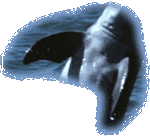 |

|
Pectoral FinsAs in all cetaceans, the forelimbs have evolved into pectoral fins. Dolphins have well-developed pectoral fins (flippers) placed behind the head and below the midline. The flippers vary widely in shape, size and colour from one species of dolphins to another. Flippers are important in steering and stopping. They provide excellent paddles for steering and stability. Shaped like paddles, these modified front limbs are used primarily for twisting, turning and for manoeuvring. The flippers also appear to be important as organs of touch in social and sexual contexts. Pectoral fins are made of cartilage and bone. They are similar to the skeletal structure of land mammals with fingers and ball and socket joints. In some cases, the flippers are held rather rigidly out from the body as dolphins have a stiff foreflipper without the movable elbow joint in most mammals. | ||||
|
BibliographyHarrison, Sir Richard, et. al. Whales, Dolphins and Porpoises. New York: Facts on File, Inc., 1994. Mark Carwardine, The Book of Dolphins. Dragon's World Ltd, 1996 Tursi. "Tursi's Dolphin Page" Available http://www.neteng.bc.ca/~tursi/dolphins/index.htm, 4 September 1997, Accessed 4 April 1998 |
|
© 1998 Thinkquest Team 17963 <17963@advanced.org Modified: 14 July 1998, Created: 30 June 1998 |
